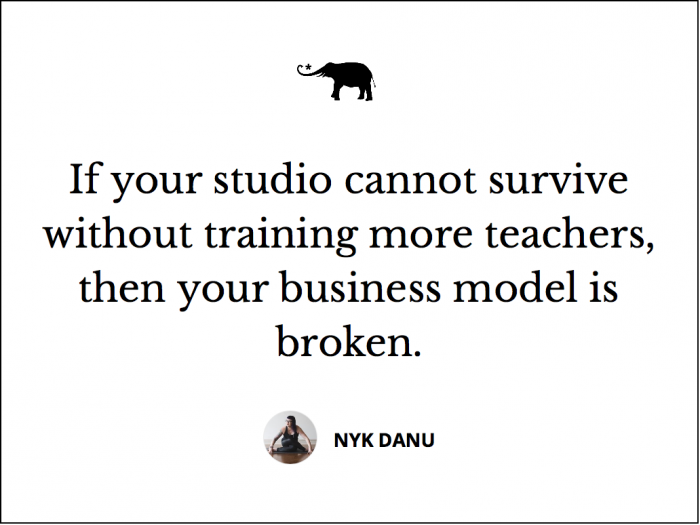Author’s note: If you owned a studio and have had to shut your doors or are a teacher who has lost a studio you called home. I see you. I have, too. It breaks my heart to see my beloved studios closing their doors. My intention with this post is not a call-out, but a call-in. I did not write this so you feel bad about your former business model but rather to shine a light on a way forward.
~
I’m standing in a studio I formerly taught in before COVID-19 that is shutting its doors for good.
I’m there to pick up a few of my things and buy a mala as a tiny attempt to help support the owner of what was a Yoga home to me.
I’m just about to leave when she asks, “What do you think is going to happen to the Yoga Industry?”
I freeze, not wanting to answer. Not because I don’t have an opinion, I’ve been self-employed for 30 years, 16 of those as a Yoga teacher. I’m a Yoga business mentor for Yoga teachers; I have a lot to say on this.
I hesitate because I know she won’t like my answer. Because everything I’m about to say about the Yoga Industry and what’s wrong with it (in my opinion) she had been doing for years, and it sadly added to the studio’s downfall.
You see, the Yoga-canary in the coal mine has been chirping frantically for a long time. We’ve just been too busy OM-ing to hear it.
Now the canary is dead, and studios are going belly up.
The Yoga business model has been broken ever since I got out of my teacher training in 2004, and it’s progressively gotten worse each year.
But it seems the yogaverse has been too busy drinking green juice and buying Lululemon to notice.
Will Yoga survive COVID-19? Of Course! But it won’t be the way it was, not ever again, and I think that’s not a bad thing.
So, where did it all go wrong? Here are four observations:
1. Yoga as fitness
Yoga used to be an obscure, counterculture activity. Rare and hard to find. Even when I started practicing in the 90s, there were only a few studios, and no one I knew personally practiced it.
Studios were small mom-and-pop operations, and some were just sublet in dance studios and community halls.
At some point, when Vinyasa Yoga started to take off, it became another way to get a workout as opposed to a work-in.
It shifted from a small loyal, committed group of students to the latest fitness trend to a way to detox, sweat, and get your Yoga-butt. The classes got stronger and hotter to the point that many students now don’t even know there is Yoga beyond a heated room.
2. Drop-in classes killed Yoga
This trend equating Yoga with fitness meant that now the studios treated their business models like a gym. Gone were the small, intimate, pre-registered series that meant students were committed to learn, study, and being part of a community.
Instead, studios went to memberships, 10-class punch cards, and drop-in classes.
None of which are sustainable, even with packed classes.
3. Fancy pants
At this point, many studio owners are barely making it (thanks to the fitness-obsessed, drop-in model), and so they start scrambling to bring in more money.
Studios add retail, and not just basic stuff like a few props students can use for home practice but 200-dollar pants (likely made in a sweatshop somewhere), Yoga art, greeting cards, and essential oils, just to mention a few.
Now I like my leggings as much as other Yoga teachers, but I know I can just as effectively practice in my pyjamas. Those things have nothing to do with Yoga practice.
4. The teacher training puppy mill
Okay, so it’s becoming clear that studios still aren’t making enough money, so they start offering teacher training.
Which just pumps out more and more under-qualified teachers. Teachers who think once they graduate, they will be flooded with teaching opportunities, Instagram followers, and sponsorships.
If your studio cannot survive without training more teachers, then your business model is broken.
Imagine if a Martial Arts Dojo could only survive financially by training other martial arts teachers? How long would it take before the market went from long-term experienced, dedicated teachers to swimming in under-qualified and inexperienced teachers?
Well, if Yoga is an example, the answer is about 10-15 years.
Okay, so if right now you are thinking okay, boomer (proudly GenX actually), quit talking about the way things used to be. What do we do now to save our Yoga business?
I’m glad you asked; I have four ideas on that:
1. Stop marketing Yoga as a workout.
Will you get fewer students, sure, but the ones you have will be more loyal and committed.
This way, you can also start making Yoga accessible to people (and there are a lot of them) who have never come to your classes before.
2. Say goodbye to punch cards.
Have a membership model and/or run registered series. This can work. It’s how I started in Yoga. It’s how I have run my classes.
It will take time, and it won’t be for everyone. But you will make more money (without charging more) and build a community of loyal, committed students who are happy to tell their friends.
3. Stop pumping out more under-qualified teachers.
A huge percentage of the people who take a teacher training never teach. Many of them don’t even want to. They want to learn more about Yoga and deepen their study.
So give the people what they want.
Imagine if you took all the info in your current teacher training and just took out the how-to-teach part now offer that as a Yoga immersion to anyone who feels called to study.
Then if you insist on still offering teacher training, you can make the immersion pre-required for the teacher training, and you can offer longer, more in-depth training for those serious about teaching and advanced education for those who are committed teachers.
4. Consider closing your brick and mortar.
Paying high rent in an industry that now thinks of Yoga as a workout is what created this mess. What if you sublet space, so you are only paying for it when you need it?
I know many long-term teachers that rent out space from churches, community centers, and the like. Why pay for space 24/7 when you are only using it for six to nine hours a day?
I know none of what I have said is easy, but if you love Yoga and want to see it thrive—this is the only way forward that I can see.
~










Read 39 comments and reply